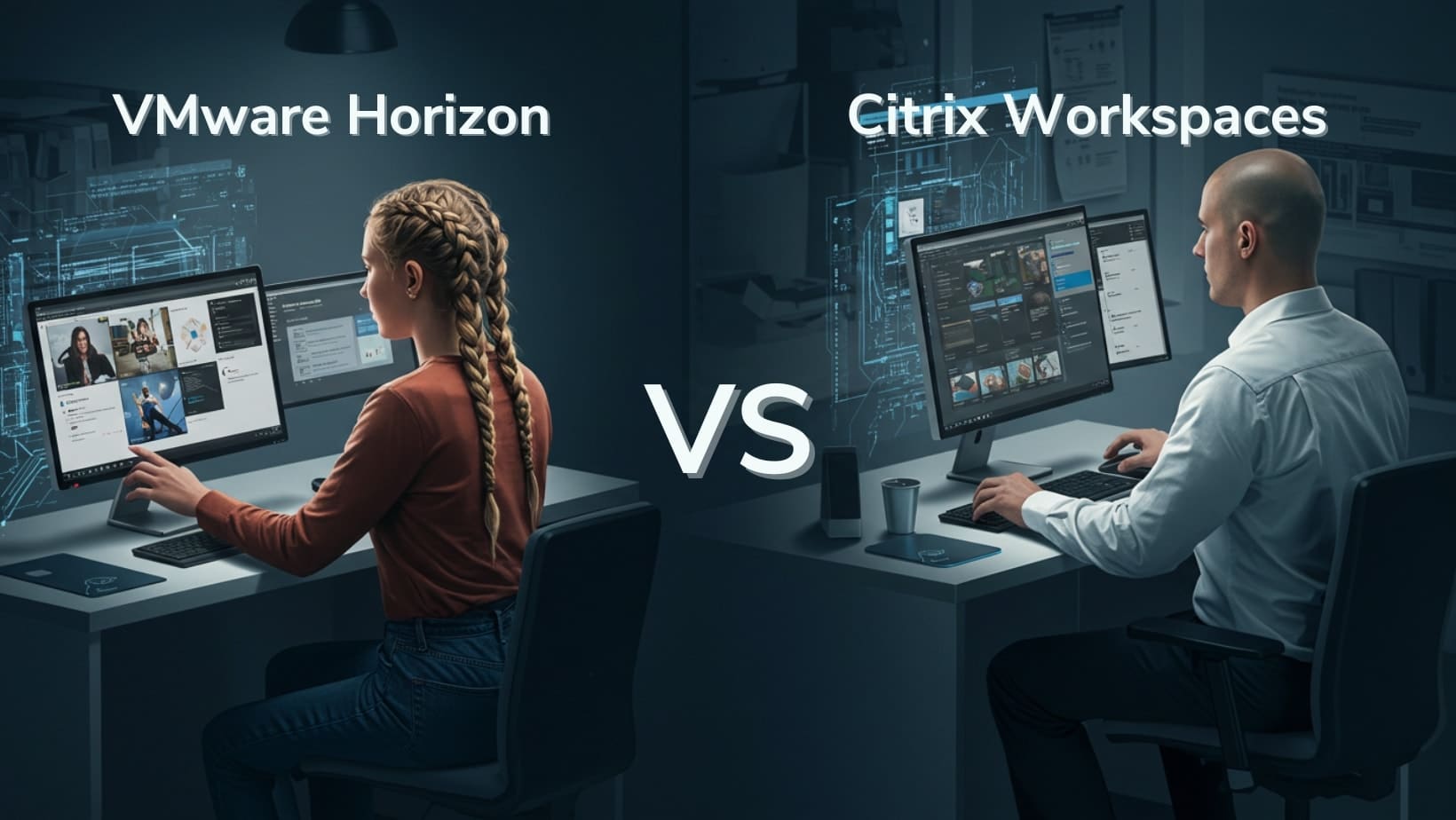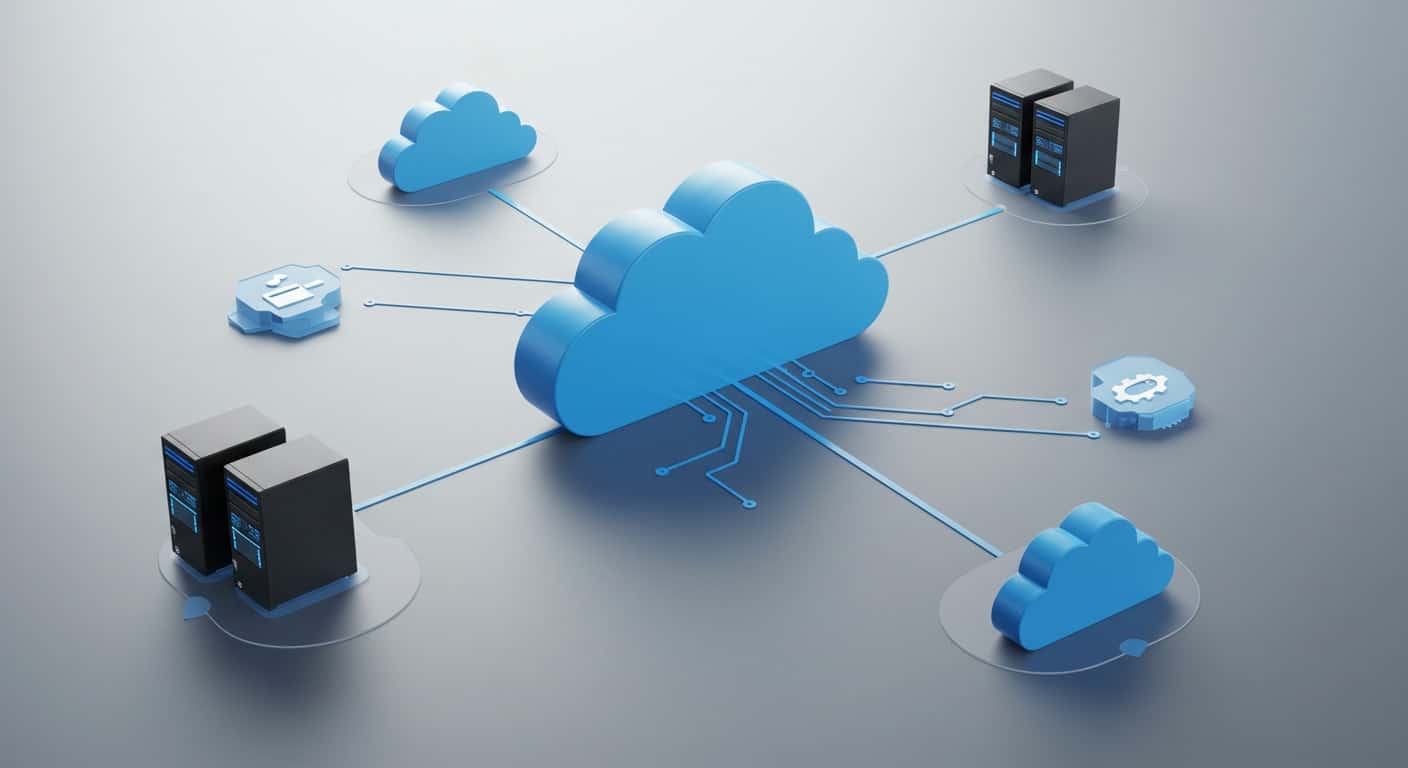Virtual desktop infrastructure (VDI) has quickly become a central component of how businesses and institutions support remote work, learning, and secure access to applications.
With teams now working from nearly anywhere and IT departments under increasing pressure to support flexible environments, the demand for scalable, secure, and efficient virtual desktop solutions continues to rise.
Two of the most recognized platforms in this space are VMware Horizon and Citrix Virtual Apps and Desktops (CVAD). Both are well-established, widely adopted, and packed with features tailored to complex enterprise environments.
If you’re exploring VDI for your organization—or reevaluating your current setup—chances are you’ve come across both.
This article provides a detailed, side-by-side comparison of these two solutions. You’ll learn where they shine, where they fall short, and what each brings to the table in terms of performance, management, and scalability.
And along the way, you’ll see how a modern, streamlined approach—like the one offered by Apporto—can help bypass much of the legacy complexity without compromising on performance or security.
2. Overview of VMware Horizon and Citrix
Understanding the core of each platform helps set the stage for a more detailed comparison. Both VMware Horizon and Citrix Virtual Apps and Desktops offer robust desktop virtualization capabilities, but they approach it from slightly different angles.
What is VMware Horizon?
VMware Horizon is VMware’s flagship virtual desktop and app delivery platform. It’s deeply integrated with the broader VMware ecosystem, including VMware vSphere, VMware ESXi, and Horizon Cloud. This makes it a natural fit for organizations already invested in VMware’s infrastructure stack.
Key features include:
- Instant Clones for rapid desktop deployment
- App Volumes for real-time application delivery
- Dynamic Environment Manager for personalized settings
- Seamless use of local resources on the end user’s device
VMware Horizon is also well-positioned in hybrid environments, with native support for VMware Cloud, Microsoft Azure, and Google Cloud.
What is Citrix Virtual Apps and Desktops (CVAD)?
Citrix CVAD, meanwhile, is known for its fine-grained control and broad application delivery capabilities. Built on Citrix Hypervisor and integrated with Citrix Workspace, it leverages technologies like HDX for optimized performance—especially under low bandwidth.
Notable components include:
- Citrix DaaS (Desktop as a Service)
- Machine Creation Services and Provisioning Services
- Citrix Studio for VDI management
- Advanced tools for adaptive authentication and granular policy enforcement
Both platforms are enterprise-grade—but that doesn’t always mean they’re the right fit for everyone.
3. Architecture and Infrastructure Compatibility
The strength of a VDI solution starts at the foundation. That means compatibility with your existing infrastructure—whether it’s on-premises, cloud, or hybrid—is critical.
Both VMware Horizon and Citrix Virtual Apps and Desktops offer flexible architecture options. But they take different routes to get there.
Here’s a quick side-by-side breakdown:
| Folder Path | What It Contains |
|---|---|
| ~/Library/Application Support/Citrix | Configuration and runtime data |
| ~/Library/Preferences | Settings and user preferences |
| ~/Library/Logs | System logs related to Citrix |
| ~/Library/LaunchAgents | Startup scripts and services |
VMware Horizon is built to work best with VMware ESXi and vSphere. If your environment already runs on VMware, the integration is seamless.
Citrix supports more hypervisors out of the box, including Microsoft Hyper-V and Citrix Hypervisor. That gives you more flexibility across varied environments.
Both solutions support public cloud deployments. You’ll find integrations with Microsoft Azure, Google Cloud, and in VMware’s case, VMware Cloud on AWS.
When it comes to image management, the differences matter. Citrix offers both Machine Creation Services (MCS) and Provisioning Services (PVS) for more control and customization.
VMware uses instant clones, which are fast and efficient but may offer less flexibility in certain use cases.
Ultimately, both platforms can scale. But they require infrastructure expertise—and a fair amount of ongoing management.
That’s where solutions like Apporto set themselves apart. They eliminate the need to manage hypervisors or image creation entirely.
4. User Experience and Performance
A virtual desktop platform should feel seamless for the end user, even if the backend is complex. Citrix and VMware both focus heavily on this, but they take different routes to get there.
Interface & UX
Citrix is known for its HDX technology, which delivers smooth performance even over low bandwidth connections. It’s especially strong in environments where internet quality varies or dips unexpectedly.
VMware focuses on a unified workspace and integrates closely with App Volumes for on-demand app delivery. It also handles local resource redirection—like USB devices or printers—with impressive ease.
From a visual standpoint, VMware’s interface feels more modern and intuitive. Citrix’s UI is functional but may require a steeper learning curve for some users.
End-User Experience
Performance-wise, Citrix excels in low-latency environments thanks to its adaptive HDX protocol. It adjusts in real time to preserve a usable experience when bandwidth is limited.
VMware Horizon, on the other hand, typically boots faster using instant clones and offers snappier access to local files and resources. That makes it a better fit for use cases where speed and responsiveness are key.
Session stability is reliable across both platforms, though Citrix holds a slight edge in long-haul network scenarios. VMware wins when local responsiveness and integration matter most.
If you’re tired of choosing between complex tradeoffs, Apporto offers a third path—an optimized, browser-based experience with zero client-side configuration.
5. Security Features and Access Control
Security is foundational in any virtual desktop environment. Both VMware and Citrix deliver enterprise-grade protection, but each has a different approach.
VMware Horizon
VMware integrates with Dynamic Environment Manager, allowing policies to be tailored to users, devices, and locations. This makes security deeply personalized, but also adds complexity for IT teams managing large deployments.
App Volumes can be encrypted, and there’s support for audit logging and role-based access. These features are powerful, but they require VMware ecosystem familiarity to configure effectively.
Citrix Virtual Apps and Desktops
Citrix offers fine-grained control using Citrix Studio and App Layering. You can build detailed policies around session behavior, data sharing, and app access.
Its adaptive authentication supports multiple identity providers and custom rules. While the control is strong, setup can be time-consuming and often requires scripting or third-party integrations.
The Tradeoff
Both platforms offer multi-factor authentication and application-level protection. But high configurability comes with increased overhead, leading to longer setup times and potentially higher support costs.
Vendor lock-in is another concern—once you’ve customized deeply, switching becomes difficult. That’s why Apporto was built to deliver built-in security that works out of the box, without specialized setup or management tools.
6. Licensing and Cost Management
Licensing models can quickly become one of the most frustrating parts of managing VDI. Both Citrix and VMware rely on layered pricing structures, which may feel overwhelming if you’re not deeply embedded in their ecosystems.
Separate Licenses & Management Complexity
VMware Horizon uses a mix of on-premises licenses, Horizon Cloud subscriptions, and separate add-ons like App Volumes and Dynamic Environment Manager. Each layer often requires individual tracking and renewal, which can complicate budgeting and planning.
Citrix, on the other hand, splits licensing across Citrix Workspace, Citrix DaaS, and enterprise features such as advanced image management or adaptive security. This makes scalability possible, but not always straightforward—or affordable.
Scalability and Cost Efficiency
In large CVAD environments, costs can escalate quickly due to infrastructure requirements and licensing tiers. Even though VMware offers more flexibility through cloud partnerships, managing multiple agreements still takes effort.
Organizations often underestimate the management costs tied to licensing audits, renewals, and version mismatches. The more moving parts involved, the higher the chances of unexpected costs.
This is one reason more teams are exploring modern VDI alternatives like Apporto. With flat-rate pricing and no layered licenses, it’s a simpler way to scale without financial guesswork.
7. Deployment and Management
How you deploy and manage your virtual desktop solution can shape long-term success. Complexity during setup often leads to delays, missed rollouts, or increased reliance on third-party consultants.
VDI Deployment Tools
Citrix offers tools like Machine Creation Services (MCS), Provisioning Services (PVS), and Citrix Studio. These enable highly customized deployments, but they also require detailed configuration and a deep understanding of Citrix architecture.
VMware Horizon relies on Instant Clones, App Volumes, and Dynamic Environment Manager, which allow quicker provisioning and simpler image management. If you’re already using vSphere, setup tends to be smoother and more integrated.
Ease of Setup
Citrix is often praised for its granular control, but that control comes at the cost of a steeper learning curve. It’s powerful, but setup and updates can be time-intensive, especially in large enterprise environments.
VMware is generally easier to implement—if you’re already invested in the VMware stack. But for new users, the number of components and dependencies can still feel like a lot.
That’s why many organizations are turning to Apporto, which eliminates installation and infrastructure configuration altogether. With a fully managed, browser-based VDI, your deployment timeline can shrink from weeks to hours.
8. Cloud and Hybrid Environment Integration
Cloud compatibility is a key consideration for organizations building flexible, future-ready infrastructure. Both Citrix and VMware provide options to connect with leading public cloud platforms.
VMware Horizon integrates directly with VMware Cloud on AWS, Microsoft Azure, and Google Cloud. It works best when you’re already using VMware vSphere and want to extend those resources into the cloud.
Citrix connects natively with Citrix Cloud, Azure, and other public cloud providers. It gives you more deployment options, but often at the cost of added configuration steps.
When it comes to hybrid environments, both vendors support combining on-prem and cloud workloads. However, setting them up correctly can be intricate and may require additional licenses and advanced planning.
There’s also the risk of vendor lock-in, especially when environments become deeply customized. Solutions like Apporto offer cloud-native VDI without the tangle of hybrid complexity or proprietary infrastructure dependencies.
9. Which One Is Best for Your Organization?
Choosing between VMware Horizon and Citrix really depends on your organization’s priorities and existing systems. Each platform brings strengths—but also comes with tradeoffs.
If you’re heavily invested in VMware infrastructure, Horizon may feel like the most natural fit. It integrates well with vSphere and offers solid tools for fast deployment and local resource access.
Citrix is ideal for teams that need deep customization, app-focused delivery, and fine-grained control over user policies and access. It’s powerful, but the learning curve and management overhead are steeper.
However, if your focus is on simplicity, fast rollout, and an exceptional user experience, you might want to consider an alternative. Apporto provides a browser-based VDI that works without installing clients, managing hypervisors, or navigating complex licensing.
In many cases, it’s not about picking the biggest platform—but the one that makes your day-to-day work easier and more efficient.
10. Apporto: A Modern Alternative to Legacy VDI
If you’re starting to feel that both VMware and Citrix demand more than they give back, you’re not alone. Traditional VDI platforms often come bundled with hypervisor management, complex licensing, and image maintenance headaches.
Apporto was built to break away from that cycle. It delivers a fully browser-based desktop experience—no local installs, no agents, and no servers to maintain.
You can deploy virtual desktops in a matter of hours, not weeks. Whether you’re supporting remote teams, educational institutions, or enterprise users, setup is fast and painless.
There’s no need for deep infrastructure knowledge or specialized roles. Users can connect from any device, and IT teams manage everything from a simple, cloud-based dashboard.
Apporto also avoids the patchwork licensing you often find in legacy systems. Pricing is transparent, scalable, and built for clarity—not confusion.
It’s designed for the modern workforce, where agility, usability, and speed matter more than deep customization or legacy integrations. If your priority is focusing on end users—not maintaining infrastructure—Apporto is built for you.
11. Conclusion
Both VMware Horizon and Citrix Virtual Apps and Desktops are powerful platforms. They’ve led the VDI market for years and offer deep features for complex enterprise environments.
But with that power comes complexity, overhead, and ongoing maintenance. Between licensing layers, configuration demands, and infrastructure dependencies, the cost of control can be high.
For teams looking to simplify, Apporto offers a different approach. It removes the need for hypervisors, reduces setup time, and delivers a fast, secure experience through any browser.
Whether you’re supporting a remote workforce, launching an education platform, or scaling desktops on demand, Apporto removes the friction. It gives you more time to focus on users, not servers.
Looking to simplify virtual desktop delivery? Explore how Apporto offers a better way forward.
12. Frequently Asked Questions (FAQs)
1. Is VMware Horizon better than Citrix?
That depends on your infrastructure. Horizon integrates well with VMware environments, while Citrix offers more flexibility and control.
2. Can I use Citrix on Microsoft Azure?
Yes. Citrix Cloud has native integration with Microsoft Azure for scalable cloud deployments.
3. Does either solution work well on low bandwidth?
Citrix, with HDX technology, tends to perform better in low-bandwidth scenarios.
4. What’s the simplest VDI solution for remote work?
Apporto offers the most straightforward experience—no installs, no configuration, and fully browser-based access.
5. How does Apporto compare to legacy VDI providers?
Apporto eliminates the complexity of Citrix and VMware, offering a modern, fast, and low-maintenance alternative.










